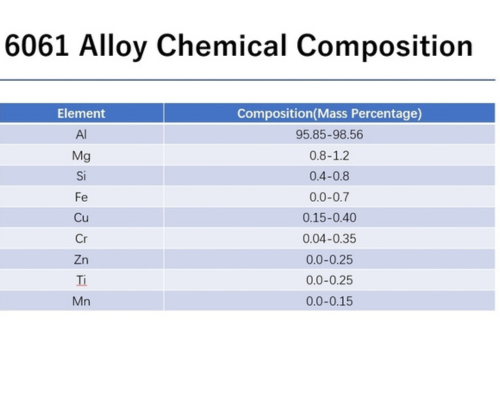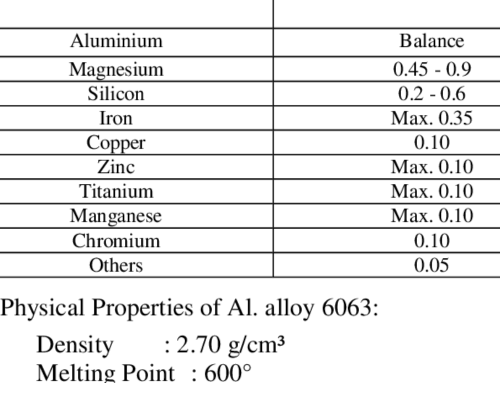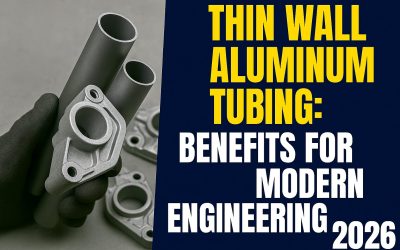6061 vs 6063 aluminum what is the difference? Aluminum is used in almost every industry and 6061 and 6063 belong to the most popular alloys of the 6000 series. They are common in construction, transportation and architecture. They possess certain features which qualify them for different uses. Reading this article, you will discover why some alloys are better than others, what kind of alloys are better when using one or another, etc.
6061 aluminum alloy is more robust and durable, so it is ideal for structural and industrial applications. In contrast, 6063 aluminum alloy has better resistance to corrosion and a smoother finish and is, therefore, better for architectural or ornamental applications. This comparison will enable you to identify the right alloy for your project.
1. Alloying Elements of 6063 vs 6061:
Magnesium (Mg):
6051 and 6069 use magnesium as their main alloy, and in the same group, aluminum is also present. It creates precipitates within the aluminum matrix that restrains the dislocation motion, thus enhancing its strength Magnesium content: 6061 – 0.8-1.2%; 6063- 0.45-0.9%. This leads to a higher strength in the 6061 alloy, it should be noted.
Silicon (Si):
Silicon refines the alloys by enabling easier casting with a lower melting point compared to the working temperature. It also strengthens solutions by the formation of Mg₂Si precipitates; 6061 includes 0.4 – 0.8% Si, while 6063 has 0.2 – 0.6% Si.
Copper (Cu):
Copper is found in small amounts (0.15- 0.4 %) in 6061. It raises the strength significantly, especially when subjected to heat treatment. However, it can negligibly affect corrosion resistance. Usually, 6063 alloys contain very low levels of copper.
Chromium (Cr):
6061 contains 0.04-0.35% of chromium added. It controls grain structure and property of excellent corrosion resistance. 6063 aluminum will include a lower chromium content.
Iron (Fe):
Iron is a common element that forms with both alloys to cause impurities. However, everyone knows that in case of an increase in the amount of iron, its undesirable impact on ductility and toughening can decline.
Typical Chemical Composition Ranges:
| Element | 6061 | 6063 |
| Aluminum (Al) | Balance | Balance |
| Magnesium (Mg) | 0.8 – 1.2% | 0.45 – 0.9% |
| Silicon (Si) | 0.4 – 0.8% | 0.2 – 0.6% |
| Copper (Cu) | 0.15 – 0.4% | < 0.1% |
| Chromium (Cr) | 0.04 – 0.35% | < 0.1% |
| Iron (Fe) | < 0.7% | < 0.35% |
2. Overview of Aluminum Alloy 6061
Aluminum 6061 is widely used in making extruded parts, structural frames, automotive parts, and welding. Its magnesium and silicon enhance the strength-to-weight ratio. Making it suitable for any project that requires strength but no added weight.
Composition and Properties:
6061 is a aluminum based alloy that has its major alloying parts as mg 0.8 – 1.2%, Si 0.4 – 0.8%. They make its mechanical properties superior, and the melting point decreases, making it easier to process.
Key Features:
The alloy also has high tensile strength, which means that an applied force should not easily overcome the body. It can also be easily machined, welded, and shaped, making it ideal for GIS. In addition, 6061 can be heat-treated with the temper types T4 and T6. They are popular for boosting strength. While the alloy is corrosion-protected, it is not as efficient for use in aggressive conditions as 6063.
Applications:
This alloy is used in aerospace and naval industries, automobiles, and constructions such as bridges. It is ideal for power applications where strength and sturdiness are needed when handling projects.
3. Overview of Aluminum Alloy 6063
Aluminum 6063, also known as “architectural aluminum,” has an excellent surface finish and high resistance to corrosion. Compared to 6061, it is less stiff and harder to form and is best suited for applications that will be sandblasted and exposed to weather elements.
Composition and Properties:
Similar to 6061, 6063 is an aluminium-magnesium silicate alloy with slightly lower quantities of magnesium ( 0.45 – 0.9%) and silicon ( 0.2-0.6 %). This gives 6063 a smooth surface and makes it suitable for extrusion in die casting aluminum.
Key Features:
While 6063 is not as strong as 6061, its versatility to be extruded in different complex shapes makes it preferable for architecture. It is quite resistant to corrosion, especially when the aluminum has been anodized, providing the material with great endurance outdoors.
Applications:
It is most often used in window and door frames, roofing, furniture, and piping, among other applications. Its shiny surface can be used in ornamental and constructional operations for beautiful and utilitarian purposes.
Heat Treatment in 6061 vs 6063 aluminum:
It is also evident that heat treatment plays a vital role in enhancing the mechanical properties of both alloys. The process involves:
Solution Heat Treatment: This involves heating the alloy to a high temperature (500°C) to dissolve the alloying species into the aluminum matrix.
Quenching: The alloy is quenched (normally in water) to ‘solidify’ the dissolved elements in a supersaturated solid solution state.
Aging: The above-stated alloy is then maintained at a comparatively lower temperature (around 160-180 °C) for a certain time. It also makes it possible to selectively precipitate matrices (like Mg₂Si). It also controls the extent in order to improve the strength and hardness.
Temper Designations:
T4: Solution to heat treatment and natural aging. Has good formability and moderate strength of standard aluminum alloys.
T6: Solution heat treated and artificially aged. It gives substantially higher strength and hardness than the usual strength and hardness produced by traditional strategies.
T5: Intermediate products from an elevated temperature shaping process and artificially aged.
Microstructural Changes:
Heat treatment modifies properties equally by controlling the size and distribution of precipitates in the material. The artificial aging (T6) exhibits fine and uniformly distributed precipitates which in turn offer higher strength compared to the natural aging (T4).
Corrosion Resistance 6061 aluminum vs 6063:
Aluminum putrefies spontaneously, and its surface turns into a type of oxide that avoids further oxidation. However, some environmental conditions can corrode this layer.
Types of Corrosion in 6061 vs 6063 aluminum:
Pitting Corrosion: Isolated attack that produces a small, distinct pit or hole. The iron content is more frequent in the 6061 aluminum due to the presence of copper in it.
Galvanic Corrosion happens when aluminum conducts with a more honorable constituent metal, such as copper, to form an electrolyte such as salty water.
Stress Corrosion Cracking: Surface cracks resulting from the action of tensile stress and the presence of a corrosive substance. In the case of 6061, chromium does this job to prevent this.
Anodizing: An electrochemical procedure that enlarges the original oxide layer, substantially improving corrosion protection, wear protection besides making it suitable to be painted or dyed even better for 6063, used for architectural purposes.
4. More Detailed Comparisons 6061 aluminum vs 6063:
Mechanical Properties 6061 vs 6063 aluminum (T6 Temper):
| Property | 6061-T6 | 6063-T6 |
| Tensile Strength (MPa) | 310 | 228 |
| Yield Strength (MPa) | 276 | 186 |
| Elongation (%) | 10 | 12 |
| Fatigue Strength (MPa) | 97 | 76 |
6061 contains magnesium and silicon, and these two types differ in properties that qualify each for specific market use.
Strength:
6061 is tougher and has more tensile strength than 6063. This makes it acceptable for basic objectives and apparatus for producing pieces. 6063 has a comparatively lower yield strength than 6082. It can be used for non-structural applications such as window frames or railings.
Corrosion Resistance:
They both are anti-corrosive, but 6063 scores higher, especially when anodized. That is why this option is selected when further development will be subjected to environmental influences, such as moisture or corrosion, such as outdoor furniture or irrigation systems.
Thermal Properties:
6061 is more rigid because it also has a lower coefficient of thermal expansion. This means it does not expand extensively upon exposure to heat, in contrast to 6063. It has a high thermal conductivity. Thus, 6061 is more stable when used in places with frequent temperature changes.
Machinability and Weldability:
6061 is easier to work as well as metal, making it superior for use where shaping is necessary. Still, 6063 has a much better surface finish that allows for extrusion, a technique used to create elaborate cross-sectional shapes by pushing aluminum through a die.
5. Practical Applications of aluminium 6061 vs 6063
6061 in Marine Environments:
6061 is forgivable, well corrosion resistant, and weldable so it is commonly applied to shipbuilding, boat hulls, decks and other boat-building parts. That is why it is ideal for constructing high-performance sailboats and yachts, its strength and low density.
6061 in Automotive Manufacturing:
6063 is a popular variety in the electronics sector due to the material’s good heat conductivity. They are used in heat sinks which help cool glued electronics so that heat does not destroy them.
6061’s high strength-to-weight ratio makes it valuable in automotive manufacturing. It’s used in structural components, body panels, and even some engine parts, contributing to vehicle lightweight and fuel efficiency.
6063 in Architectural Cladding:
In architectural applications, 6063 wins the favor of users because of its superior corrosion resistance performance and the fact that it can be anodized in different colors. Storm Hard coatings offer a long-lasting, relatively attractive protective covering for buildings.
Other Alloys in the 6000 Series
However, the most popular materials in this series are 6061 and 6063, although the 6xxx group contains other members with unique characteristics. For example:
6005: Applied more commonly for extruded architectural uses, providing good strength in combination with extrudability and corrosion resistance.
6082: Having high strength and fatigue resistance and thus being desirable for applications which have high structural requirements.
6463: Used for anodizing, gives bright and uniform color suitable for the aesthetic application.
6. Choosing from 6061 vs 6063 aluminum
It might be wiser to consider what makes the most difference in use when comparing 6061 and 6063 aluminum.
Choose 6061 if you are working on a project that requires high strength, is easy to make, and requires some levels of stress in strenuous conditions. This is particularly crucial for high-strength end-use items such as aircraft parts, auto parts, or industrial products. If corrosion protection and glossy surfaces matter to you, then choose 6063.
This is a brilliant alloy for anyone intending to build utensils that should serve as ornaments and withstand the outdoor environment, such as window frames, decorative panels, or outdoor furniture.
Cost Comparison Aluminium 6061 vs 6063
Relative Cost: 6063 is normally 10 to 15% cheaper than 6061 because of the smaller addition of alloys.
Factors Affecting Cost:
Alloying content of 6061 is relatively high, leading to a high raw material cost.
Manufacturing process: Extrusion is cheaper than other methods, such as forging, so the prices of 6061 products may be affected.
Market conditions: Aluminum has its own supply and demand chain, and aluminium’s price varies with it.
Example Cost Comparison 6061 vs 6063 aluminum (Approximate):
| Product Form | 6061 | 6063 |
| Sheet (per lb) | $3.50 – $4.00 | $3.00 – $3.50 |
| Extrusion (per foot) | $5.00 – $7.00 | $4.00 – $6.00 |
7. Conclusion
Altogether, 6061 vs 6063 aluminum are highly in demand. 6061 is eminent for strength and flexibility, making it suitable for structures and industrial projects. However, 6063 is superior in corrosion resistance, and its surface is finer, which is why it is used in architecture and ornamental purposes.







0 Comments